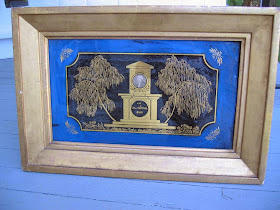Today the antiques field will be bidding farewell to one of our own, who passed peacefully in his 90th year on Wednesday. He was an antiques dealer through and through and a wonderful man. I thought it an appropriate time to talk about a rather intriguing area of study, the art of the memorial. In the 18th and 19th century, when death was a much more present and persistent aspect of life, many found comfort by honoring their lost loved ones with memorials. These memorials took many forms, jewelry and portrait miniatures which could be worn close to the heart, and artwork and textiles which could be proudly displayed on the wall. This art form reached a fever pitch in America in the years after the death of President George Washington, when it became fashionable for young ladies to produce a piece of memorial art while in school.
 |
| Here is a silk on silk embroidery, dated July 5th, 1805 produced by a young lady while at school. She choose to memorialize the deceased first President rather than a personal loss. This arrangement is frequently seen on schoolgirl needlework of the period. |
 |
Another memorial to President George Washington c. 1800, This one completed by a professional artist with reverse painted on glass gilding and eglomise (a black slightly iridescent paint compound produced with asphaltum).
This is hanging about four feet from my desk at work. |
 |
| A close up of the memorial. |
 |
Another piece we have here at the shop, a memorial to Reverend Enoch Pond of Preston, Connecticut. The quality of this oil on paper applied to board piece indicates the hand of a professional artist or very skilled schoolgirl. Interestingly, Rev. Pond has a George Washington connection himself. At the age of 31, just three months after Pond had become minister for the local church, George Washington happened to attend his Sunday sermon on his way from New York to Hartford. Washington mentions the sermon in his journals, referring to it as a "very lame discourse".
Rev. Pond must have improved his methods in later years as
he was a popular and successful minister throughout his career. |
 |
| This schoolgirl watercolor memorial for three members of the same family demonstrates the height of the art. With repeating almost rhythmic patterns and bold graphic colors, the piece is not only a sensitive rendering of a family's loss, but also an impressive folk art masterpiece. |
 |
A fine example of a memorial miniature. These little pieces, painted by professional portrait miniature artists are generally only a couple inches tall.
Painted with watercolor on ivory, the amount of detail on these tiny pieces is astounding. They would often be worn as jewelry, hung on a fine gold chain, and tucked within the wearers garments as an intimate an constant reminder. |
 |
| Later in the Victorian era hair jewelry and hair memorial pieces became a popular way to mourn and remember a lost loved on. The hair wold be meticulously braided and arranged to make pieces such as the one above. I know it must have been difficult to make, and meaningful to the maker, but these always make my skin crawl. |
 |
| The portrait and memorial scene above are two sides to a mourning miniature painted by renowned artist James Peale for wealthy Philadelphia socialite Eliza Wescott. She and her best friend Lucy Breck fled the city in 1798 in the hopes of avoiding a yellow fever outbreak. Sadly, they both succumbed to the disease on the same day. Both their initials are painting on the double urned memorial stone. You can also see Eliza's dark locks braided and surrounding the mourning scene. You can read more about this amazing story here. |
 |
| Another schoolgirl memorial, this one produced right here in Colchester, Connecticut by Ruth Starks for her father. |













No comments:
Post a Comment